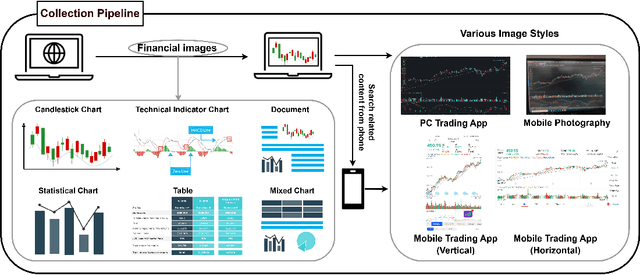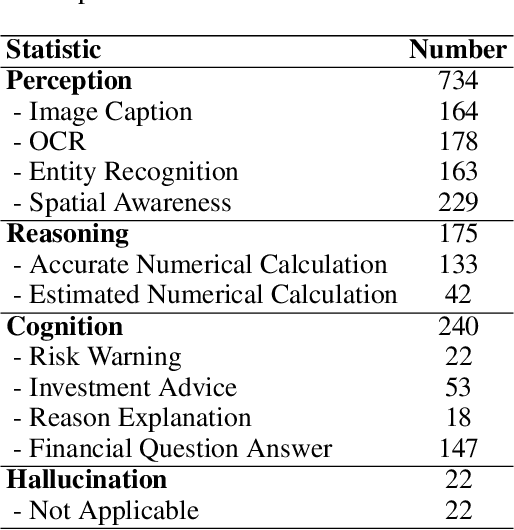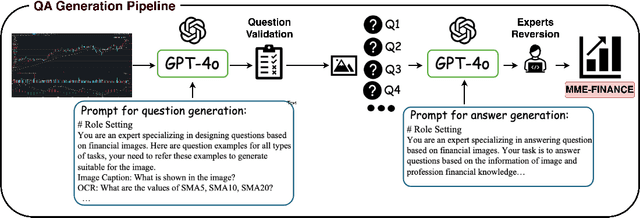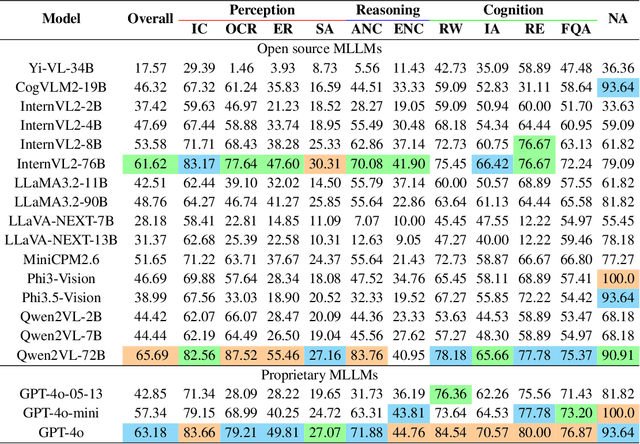Ji Liu
University of Rochester
BizFinBench: A Business-Driven Real-World Financial Benchmark for Evaluating LLMs
May 26, 2025Abstract:Large language models excel in general tasks, yet assessing their reliability in logic-heavy, precision-critical domains like finance, law, and healthcare remains challenging. To address this, we introduce BizFinBench, the first benchmark specifically designed to evaluate LLMs in real-world financial applications. BizFinBench consists of 6,781 well-annotated queries in Chinese, spanning five dimensions: numerical calculation, reasoning, information extraction, prediction recognition, and knowledge-based question answering, grouped into nine fine-grained categories. The benchmark includes both objective and subjective metrics. We also introduce IteraJudge, a novel LLM evaluation method that reduces bias when LLMs serve as evaluators in objective metrics. We benchmark 25 models, including both proprietary and open-source systems. Extensive experiments show that no model dominates across all tasks. Our evaluation reveals distinct capability patterns: (1) In Numerical Calculation, Claude-3.5-Sonnet (63.18) and DeepSeek-R1 (64.04) lead, while smaller models like Qwen2.5-VL-3B (15.92) lag significantly; (2) In Reasoning, proprietary models dominate (ChatGPT-o3: 83.58, Gemini-2.0-Flash: 81.15), with open-source models trailing by up to 19.49 points; (3) In Information Extraction, the performance spread is the largest, with DeepSeek-R1 scoring 71.46, while Qwen3-1.7B scores 11.23; (4) In Prediction Recognition, performance variance is minimal, with top models scoring between 39.16 and 50.00. We find that while current LLMs handle routine finance queries competently, they struggle with complex scenarios requiring cross-concept reasoning. BizFinBench offers a rigorous, business-aligned benchmark for future research. The code and dataset are available at https://github.com/HiThink-Research/BizFinBench.
SGDPO: Self-Guided Direct Preference Optimization for Language Model Alignment
May 18, 2025Abstract:Direct Preference Optimization (DPO) is broadly utilized for aligning Large Language Models (LLMs) with human values because of its flexibility. Despite its effectiveness, it has been observed that the capability of DPO to generate human-preferred response is limited and the results of DPO are far from resilient. To address these limitations, in this paper we propose a novel Self-Guided Direct Preference Optimization algorithm, i.e., SGDPO, which incorporates a pilot term to steer the gradient flow during the optimization process, allowing for fine-grained control over the updates of chosen and rejected rewards. We provide a detailed theoretical analysis of our proposed method and elucidate its operational mechanism. Furthermore, we conduct comprehensive experiments on various models and benchmarks. The extensive experimental results demonstrate the consistency between the empirical results and our theoretical analysis and confirm the effectiveness of our proposed approach (up to 9.19% higher score).
Týr-the-Pruner: Unlocking Accurate 50% Structural Pruning for LLMs via Global Sparsity Distribution Optimization
Mar 12, 2025Abstract:Structural pruning enhances hardware-agnostic inference efficiency for large language models (LLMs) but often struggles to maintain performance. Local pruning performs efficient layer-by-layer compression but ignores global topology. Global pruning has the potential to find the optimal solution although resource-intensive. However, existing methods tend to rank structural saliency uniformly, ignoring inter-structure dependencies and failing to achieve end-to-end optimization. To address these limitations, we propose T\'yr-the-Pruner, an efficient end-to-end search-based global structural pruning framework. This framework constructs a supernet by repeatedly applying local pruning across a range of sparsity ratios to each layer in an LLM, with the core goal of determining the optimal sparsity distribution under a target overall sparsity ratio. Concretely, we introduce an effective local pruning and an expectation error accumulation approach to improve supernet construction. Furthermore, we employ an iterative prune-and-search strategy with coarse-to-fine sparsity granularity to ensure efficient search convergence. Experimental results show that T\'yr-the-Pruner achieves state-of-the-art structural pruning, retaining 97% of the dense model's performance while removing a challenging 50% of Llama-3.1-70B's parameters.
Partial Convolution Meets Visual Attention
Mar 05, 2025Abstract:Designing an efficient and effective neural network has remained a prominent topic in computer vision research. Depthwise onvolution (DWConv) is widely used in efficient CNNs or ViTs, but it needs frequent memory access during inference, which leads to low throughput. FasterNet attempts to introduce partial convolution (PConv) as an alternative to DWConv but compromises the accuracy due to underutilized channels. To remedy this shortcoming and consider the redundancy between feature map channels, we introduce a novel Partial visual ATtention mechanism (PAT) that can efficiently combine PConv with visual attention. Our exploration indicates that the partial attention mechanism can completely replace the full attention mechanism and reduce model parameters and FLOPs. Our PAT can derive three types of blocks: Partial Channel-Attention block (PAT_ch), Partial Spatial-Attention block (PAT_sp) and Partial Self-Attention block (PAT_sf). First, PAT_ch integrates the enhanced Gaussian channel attention mechanism to infuse global distribution information into the untouched channels of PConv. Second, we introduce the spatial-wise attention to the MLP layer to further improve model accuracy. Finally, we replace PAT_ch in the last stage with the self-attention mechanism to extend the global receptive field. Building upon PAT, we propose a novel hybrid network family, named PATNet, which achieves superior top-1 accuracy and inference speed compared to FasterNet on ImageNet-1K classification and excel in both detection and segmentation on the COCO dataset. Particularly, our PATNet-T2 achieves 1.3% higher accuracy than FasterNet-T2, while exhibiting 25% higher GPU throughput and 24% lower CPU latency.
HyperZero: A Customized End-to-End Auto-Tuning System for Recommendation with Hourly Feedback
Jan 30, 2025



Abstract:Modern recommendation systems can be broadly divided into two key stages: the ranking stage, where the system predicts various user engagements (e.g., click-through rate, like rate, follow rate, watch time), and the value model stage, which aggregates these predictive scores through a function (e.g., a linear combination defined by a weight vector) to measure the value of each content by a single numerical score. Both stages play roughly equally important roles in real industrial systems; however, how to optimize the model weights for the second stage still lacks systematic study. This paper focuses on optimizing the second stage through auto-tuning technology. Although general auto-tuning systems and solutions - both from established production practices and open-source solutions - can address this problem, they typically require weeks or even months to identify a feasible solution. Such prolonged tuning processes are unacceptable in production environments for recommendation systems, as suboptimal value models can severely degrade user experience. An effective auto-tuning solution is required to identify a viable model within 2-3 days, rather than the extended timelines typically associated with existing approaches. In this paper, we introduce a practical auto-tuning system named HyperZero that addresses these time constraints while effectively solving the unique challenges inherent in modern recommendation systems. Moreover, this framework has the potential to be expanded to broader tuning tasks within recommendation systems.
EGSRAL: An Enhanced 3D Gaussian Splatting based Renderer with Automated Labeling for Large-Scale Driving Scene
Dec 20, 2024Abstract:3D Gaussian Splatting (3D GS) has gained popularity due to its faster rendering speed and high-quality novel view synthesis. Some researchers have explored using 3D GS for reconstructing driving scenes. However, these methods often rely on various data types, such as depth maps, 3D boxes, and trajectories of moving objects. Additionally, the lack of annotations for synthesized images limits their direct application in downstream tasks. To address these issues, we propose EGSRAL, a 3D GS-based method that relies solely on training images without extra annotations. EGSRAL enhances 3D GS's capability to model both dynamic objects and static backgrounds and introduces a novel adaptor for auto labeling, generating corresponding annotations based on existing annotations. We also propose a grouping strategy for vanilla 3D GS to address perspective issues in rendering large-scale, complex scenes. Our method achieves state-of-the-art performance on multiple datasets without any extra annotation. For example, the PSNR metric reaches 29.04 on the nuScenes dataset. Moreover, our automated labeling can significantly improve the performance of 2D/3D detection tasks. Code is available at https://github.com/jiangxb98/EGSRAL.
FTP: A Fine-grained Token-wise Pruner for Large Language Models via Token Routing
Dec 16, 2024Abstract:Recently, large language models (LLMs) have demonstrated superior performance across various tasks by adhering to scaling laws, which significantly increase model size. However, the huge computation overhead during inference hinders the deployment in industrial applications. Many works leverage traditional compression approaches to boost model inference, but these always introduce additional training costs to restore the performance and the pruning results typically show noticeable performance drops compared to the original model when aiming for a specific level of acceleration. To address these issues, we propose a fine-grained token-wise pruning approach for the LLMs, which presents a learnable router to adaptively identify the less important tokens and skip them across model blocks to reduce computational cost during inference. To construct the router efficiently, we present a search-based sparsity scheduler for pruning sparsity allocation, a trainable router combined with our proposed four low-dimensional factors as input and three proposed losses. We conduct extensive experiments across different benchmarks on different LLMs to demonstrate the superiority of our method. Our approach achieves state-of-the-art (SOTA) pruning results, surpassing other existing pruning methods. For instance, our method outperforms BlockPruner and ShortGPT by approximately 10 points on both LLaMA2-7B and Qwen1.5-7B in accuracy retention at comparable token sparsity levels.
Fast Occupancy Network
Dec 10, 2024Abstract:Occupancy Network has recently attracted much attention in autonomous driving. Instead of monocular 3D detection and recent bird's eye view(BEV) models predicting 3D bounding box of obstacles, Occupancy Network predicts the category of voxel in specified 3D space around the ego vehicle via transforming 3D detection task into 3D voxel segmentation task, which has much superiority in tackling category outlier obstacles and providing fine-grained 3D representation. However, existing methods usually require huge computation resources than previous methods, which hinder the Occupancy Network solution applying in intelligent driving systems. To address this problem, we make an analysis of the bottleneck of Occupancy Network inference cost, and present a simple and fast Occupancy Network model, which adopts a deformable 2D convolutional layer to lift BEV feature to 3D voxel feature and presents an efficient voxel feature pyramid network (FPN) module to improve performance with few computational cost. Further, we present a cost-free 2D segmentation branch in perspective view after feature extractors for Occupancy Network during inference phase to improve accuracy. Experimental results demonstrate that our method consistently outperforms existing methods in both accuracy and inference speed, which surpasses recent state-of-the-art (SOTA) OCCNet by 1.7% with ResNet50 backbone with about 3X inference speedup. Furthermore, our method can be easily applied to existing BEV models to transform them into Occupancy Network models.
MME-Finance: A Multimodal Finance Benchmark for Expert-level Understanding and Reasoning
Nov 05, 2024



Abstract:In recent years, multimodal benchmarks for general domains have guided the rapid development of multimodal models on general tasks. However, the financial field has its peculiarities. It features unique graphical images (e.g., candlestick charts, technical indicator charts) and possesses a wealth of specialized financial knowledge (e.g., futures, turnover rate). Therefore, benchmarks from general fields often fail to measure the performance of multimodal models in the financial domain, and thus cannot effectively guide the rapid development of large financial models. To promote the development of large financial multimodal models, we propose MME-Finance, an bilingual open-ended and practical usage-oriented Visual Question Answering (VQA) benchmark. The characteristics of our benchmark are finance and expertise, which include constructing charts that reflect the actual usage needs of users (e.g., computer screenshots and mobile photography), creating questions according to the preferences in financial domain inquiries, and annotating questions by experts with 10+ years of experience in the financial industry. Additionally, we have developed a custom-designed financial evaluation system in which visual information is first introduced in the multi-modal evaluation process. Extensive experimental evaluations of 19 mainstream MLLMs are conducted to test their perception, reasoning, and cognition capabilities. The results indicate that models performing well on general benchmarks cannot do well on MME-Finance; for instance, the top-performing open-source and closed-source models obtain 65.69 (Qwen2VL-72B) and 63.18 (GPT-4o), respectively. Their performance is particularly poor in categories most relevant to finance, such as candlestick charts and technical indicator charts. In addition, we propose a Chinese version, which helps compare performance of MLLMs under a Chinese context.
Trustworthy Federated Learning: Privacy, Security, and Beyond
Nov 03, 2024



Abstract:While recent years have witnessed the advancement in big data and Artificial Intelligence (AI), it is of much importance to safeguard data privacy and security. As an innovative approach, Federated Learning (FL) addresses these concerns by facilitating collaborative model training across distributed data sources without transferring raw data. However, the challenges of robust security and privacy across decentralized networks catch significant attention in dealing with the distributed data in FL. In this paper, we conduct an extensive survey of the security and privacy issues prevalent in FL, underscoring the vulnerability of communication links and the potential for cyber threats. We delve into various defensive strategies to mitigate these risks, explore the applications of FL across different sectors, and propose research directions. We identify the intricate security challenges that arise within the FL frameworks, aiming to contribute to the development of secure and efficient FL systems.
 Add to Chrome
Add to Chrome Add to Firefox
Add to Firefox Add to Edge
Add to Edge